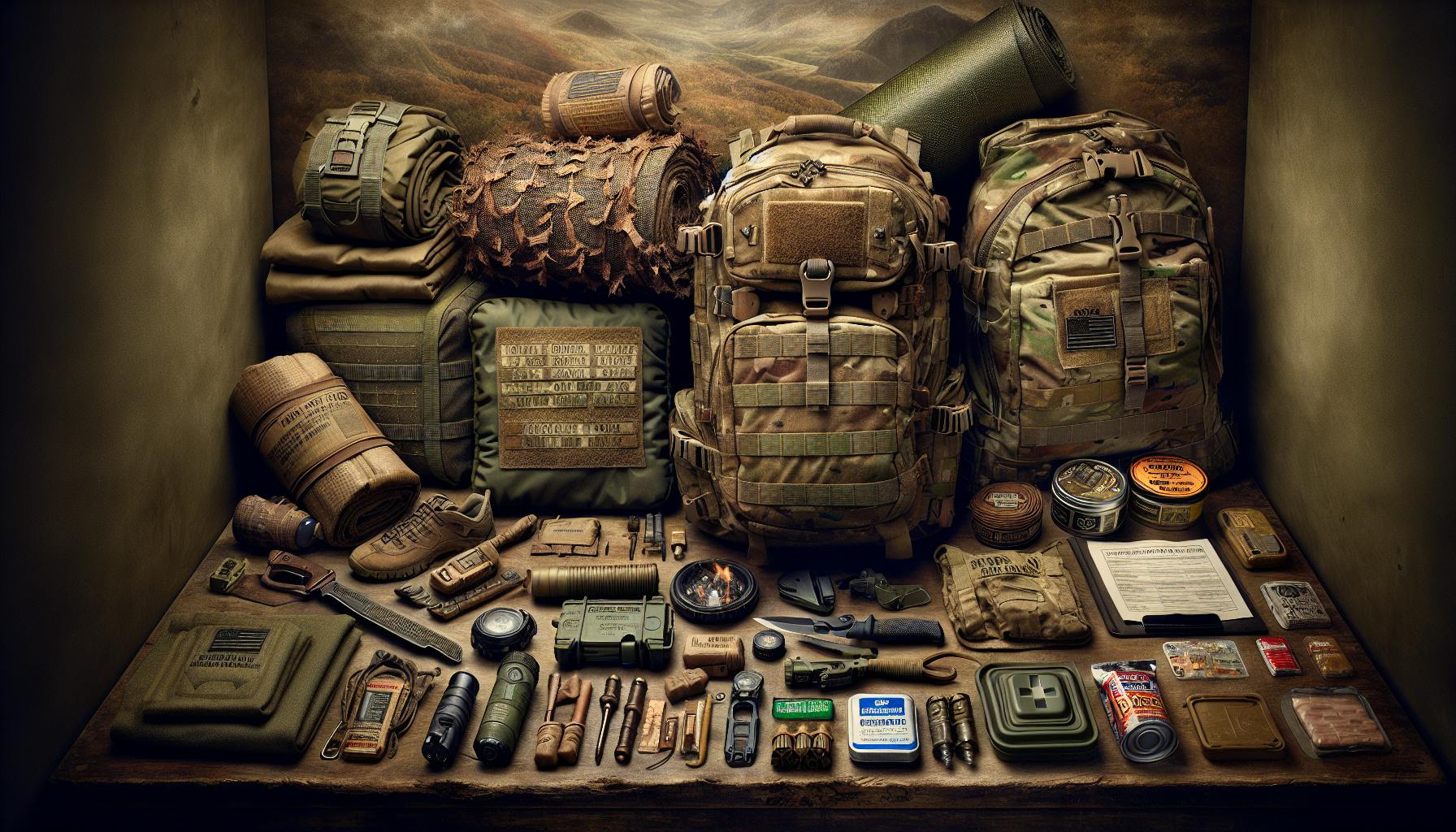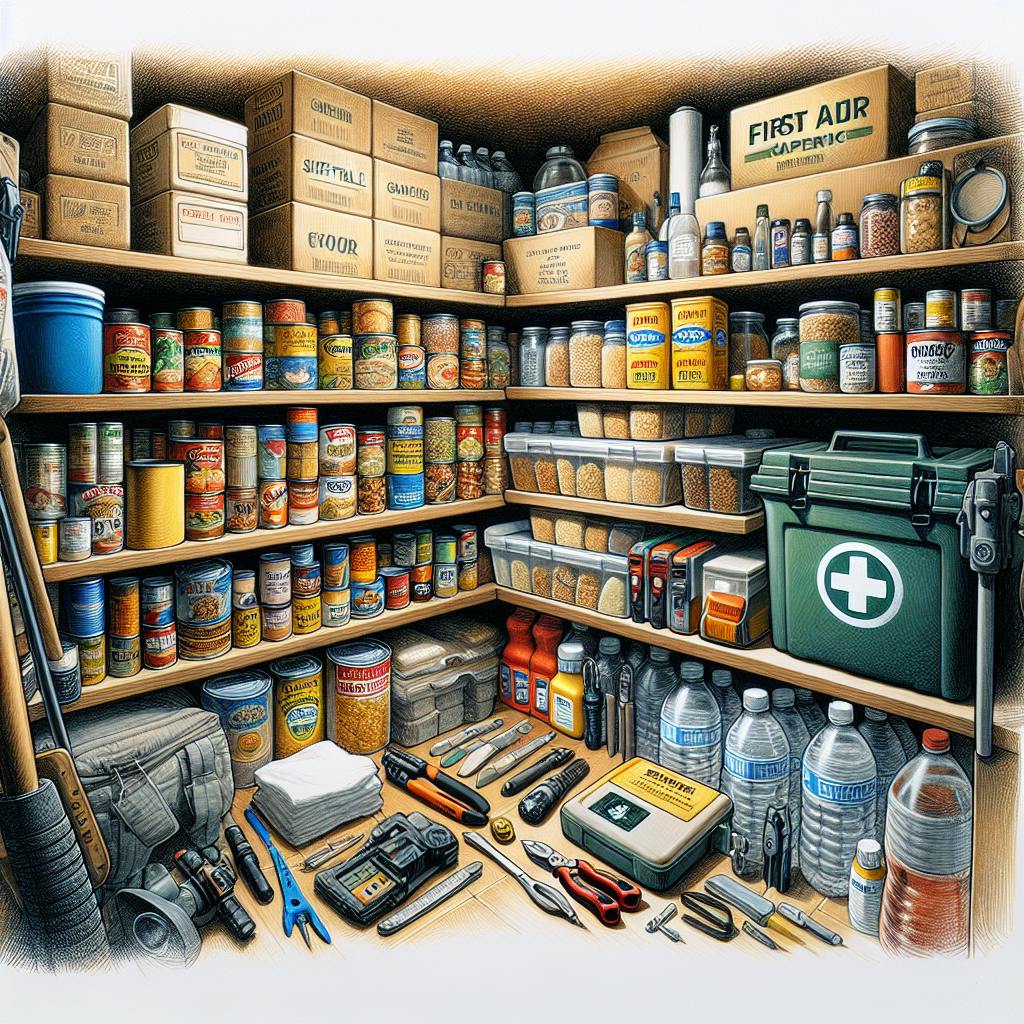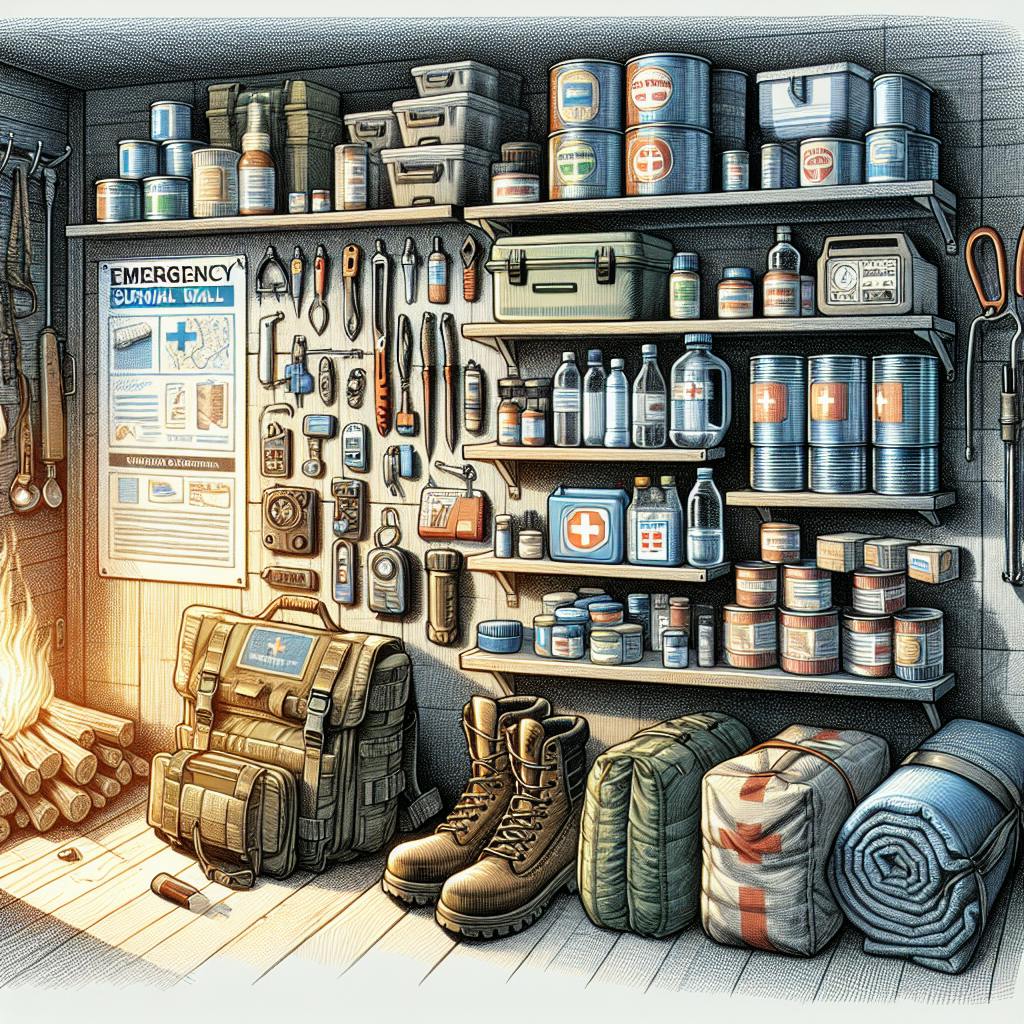Understanding the Extreme Prepper Mindset
Extreme preppers represent a dedicated subset of individuals who go above and beyond basic emergency preparedness. Driven by concerns over natural disasters, economic collapse, and social instability, extreme preppers meticulously stockpile supplies and learn specialized skills to ensure their self-reliance in the event of a major catastrophe. Having robust emergency kits is a top priority for extreme preppers, allowing them to survive for extended periods when outside assistance is unavailable. This article will cover the must-have items that preppers rely on for their emergency kits, including both essentials and specialized gear. Understanding the recommendations and techniques of extreme preppers can help everyday citizens become better prepared to handle disasters big and small.
Why Thorough Preparation Matters
Extreme preppers take emergency readiness to the limit due to their deep concerns over social and environmental vulnerabilities. Preppers point to frequent natural disasters, cyberattacks, grid failures, civil unrest, and economic instability as motivating factors. Events like Hurricane Katrina and the COVID-19 pandemic revealed how rapidly modern supply chains can collapse, leaving communities stranded. Preppers aim to hedge against these risks by building comprehensive self-reliance. While seen as overkill by some, preppers' diligence provides peace of mind that they can provide for their family no matter the circumstances. Their specialized knowledge and capabilities also enable preppers to assist others around them when calamity strikes.
Core Principles of Extreme Prepping
Several key principles guide extreme preppers in their preparedness mission:
-
Redundancy - Having back-ups and alternatives prevents single points of failure. Extra tools, food, medical supplies, power sources and more provide a safety net if one option fails.
-
Adaptability - Being ready for diverse situations requires flexible gear and multi-use items. The future is uncertain, so preppers value adaptable equipment.
-
Independence - With potential for supply chain breakdowns, preppers strive for self-sufficiency through stockpiles, renewable resources and survival skills.
-
Mobility - Bug out vehicles and evacuation plans enable relocation to safe locations if needed. Static supplies become liabilities without mobility.
-
Community - While self-reliant, preppers also build trusted mutual aid groups to cooperate and survive together.
With these core principles in mind, let's examine the gear and skills prioritized by extreme preppers.
Essential Tools and Multi-Use Gear
Rugged, reliable tools represent the foundation of every prepper's supplies. Equipment for shelter, food, water, light, cooking and repair allow preppers to provide basic necessities when infrastructure fails. Recommended categories include:
Cutting Implements - Heavy duty knives, saws, axes, and hatchets from brands like Fiskars, Estwing and Gerber allow preppers to harvest firewood, build shelters, and make tools from raw materials. Machetes like the Ontario Knife Company 18" model clear brush rapidly. Multi-tools with combined implements such as Leatherman save weight. Fixed blade knives offer durability, while folding knives improve portability.
Illumination - LED flashlights and headlamps from Streamlight, Fenix and Black Diamond provide portable light when the power grid goes down. Crank and solar-powered models like the Anker Bolder LC40 continue working by generating their own electricity. Reflectors, lanterns and glowsticks offer area lighting.
Cooking - Portable camp stoves from MSR, Jetboil and Stanley allow preppers to boil water and cook meals during power outages. Efficient alcohol and propane fuels perform well in cold weather. Dutch ovens and cast iron skillets enable cooking with open fires.
Tools - Saws, wrenches, pliers, screwdrivers and pry bars allow crucial repairs and construction. Brands like Victorinox Swiss Army and Craftsman offer compact multi-tools. Durable shovels from companies like Snow Joe dig latrines, clear debris, and bury waste. Paracord, duct tape and zip ties facilitate endless improvised fixes.
Power - Generators, solar panels and battery packs from Goal Zero, Jackery and Anker provide renewable electricity. Crank chargers and spare AAs/AAAs maintain smaller devices. Inverters run AC appliances from DC sources. Portable jump starters revive dead car batteries.
Water - Collapsible water jugs and portable water filters allow storage and retrieval. Empty fuel cans carry newfound water sources. Sturdy 55-gallon drums become rain catchments. Food grade water hoses divert flows.
Owning versatile, heavy-duty tools provides extreme preppers with capabilities to handle nearly any challenge in an emergency. Focusing preparedness efforts on reliable multipurpose items prevents having useless single-function gadgets. With quality tools on hand, preppers have confidence they can secure basic provisions for their family come what may.
Critical Water Needs for Survival
Clean drinking water represents one of the most vital considerations for extreme preppers. Having sufficient capacity to collect, store, filter, and purify water enables survival when infrastructure fails. Recommended options include:
Storage - Commercially bottled water provides convenient stockpiles. Storing tap water in food-grade 55-gallon drums and 5-7 gallon rugged jerry cans creates large reserves. Water bricks from companies like WaterBrick stack neatly.
Portability - Collapsible water carriers from Platypus, Hydrory and Nomader fold for compact transport of newfound water sources. Empty 2-liter soda bottles work in a pinch.
Filtration - Portable pump filters like the Katadyn Hiker Pro remove bacteria, protozoa and larger particulates, producing up to 1 liter per minute. Gravity systems like the Platypus GravityWorks filter up to 8 liters simultaneously.
Purification - Water purification tablets from Potable Aqua and Katadyn kill viruses and microbes. Two-part liquids like the MSR Aquatabs combine oxidation and disinfection. Portable UV lights such as the SteriPEN zap pathogens.
Distillation - Solar stills and improvised container setups enable distilling suspect water. Boiling vigorously for 1-3 minutes also eliminates biological threats.
Robust water reserves coupled with multiple methods of collecting, filtering and purifying newfound sources provides extreme preppers with sufficient clean water to survive extended utility outages. Streams, rainwater and other improvised sources become lifesavers with the right equipment.
Reliable Food Stocks and Foraging Tools
Sufficient food and nutrition represents another top concern for preppers facing disrupted supply chains. Stockpiling long-lasting staples coupled with procurement tools enables self-sufficiency. Key options include:
Stockpiles - Sealed #10 cans of freeze-dried emergency food from Mountain House and Wise Foods last 25+ years. MREs from brands like SOPAKCO pack calories and variety. Canned meats, fruits, vegetables, beans and soup provide well-rounded nutrition. Dried rice, grains, pasta and oats store efficiently. Nut butters, honey, salt and oils boost flavors and calories.
Fishing - Collapsible fishing rods from PLUSINNO, Sougayilang and other brands offer full kits for hooking fish. Fishing line, assorted hooks, lures and bait enable success. Cast nets and gill nets passively gather bounties.
Hunting - Slingshots, bows, crossbows and firearms (where legal) harvest small and large game. A Missouri state hunting permit covers numerous types of hunting. Fletching materials like feathers allow crafting crude arrows. Snares and traps catch animals humanely when unattended.
Foraging - Regional plant identification guides help locate edible berries, nuts, roots and greens. A pocket loupe magnifies distinguishing features. Gardening seeds and basic tools enable growing food later.
Preservation - Canning supplies, salt, smokehouses, curing salts and food dehydrators prevent spoilage. Vacuum sealers like FoodSaver bags extend shelf life.
A deep pantry coupled with alternative procurement methods prevents starvation if stores close. While extensive, these measures avoid reliance on any single food source. Expanding knowledge, skills and equipment for harvesting natural provisions is equally important to stockpiles.
Robust First Aid Capabilities
With medical facilities potentially unavailable, extreme preppers prepare to perform emergency medical procedures themselves. Well-stocked trauma kits and reference materials enable effective treatment. Key items include:
Stop Bleeding - Tourniquets such as the CAT or SOFTT-W halt life-threatening bleeds. Hemostatic gauze like QuikClot quickly clots wounds. Pressure dressings, chest seals, and elastic bandages control hemorrhages. Sterile suturing tools allow stitching major lacerations. Staplers and wound sealants like Dermabond offer alternatives.
Immobilize - Splints from SAM Medical, aluminum malleable splints, and improvised materials stabilize fractures. Triangle bandages create slings. Cervical collars prevent spinal injury aggravation.
Protect Wounds - Gauze pads, medical tapes, antibiotic ointments, and cleansing solutions prevent infection. Burn sheets and dressings ease pain and prevent fluid loss. Eye wash rinses irritants. Elastic wraps secure dressings.
Treat Ailments - Medications like antibiotics, antidiarrheals, antifungals, analgesics and antihistamines alleviate symptoms. Thermometers, vitamins, electrolyte solutions and medical tools enable complete care. Dental tools allow emergency procedures.
References - Printed manuals like Where There Is No Doctor provide detailed procedural instructions. First aid and wilderness EMT training develops hands-on medical capabilities.
Amassing a robust trauma kit and medical references allows extreme preppers to perform emergency dental work, stitch wounds, set fractures, assist in childbirth, and conduct other potentially lifesaving interventions with improvised tools. Medications bought ahead of time mitigate common illnesses until hospitals reopen.
Staying Oriented with Navigation Aids
Extreme preppers place high value on maintaining situational awareness and communication capabilities when infrastructure fails. Navigation tools, two-way radios, and emergency signaling devices enable critical coordination. Reliable options include:
Navigation - Waterproof topographical maps and a lensatic compass like the Cammenga allow overland travel without digital assistance. GPS devices from Garmin and emergency radios like the Midland ER310 contain compasses. Celestial observations provide direction references.
Communication - Two-way radios like the Motorola T800 provide short range communication between group members. Long range walkie talkies enable contacts beyond line of sight. Emergency radios with AM/FM bands receive broadcasts.
Signaling - Signal mirrors, whistles, flares and glow sticks attract rescuers when lost. A personal locator beacon (PLB) like the ACR ResQLink 406 sends coded emergency alerts via satellite. Markings on nearby trees or ground indicates travel path when stranded.
Power - Rechargeable batteries, generators like the Honda EU2200i, and portable solar setups from Renogy and Jackery recharge electronics. Solar chargers like the Nekteck 21W attach to packs.
Having redundant navigation and communication resources ensures extreme preppers can stay oriented, gather critical information, and call for assistance even if all infrastructure fails. Such capabilities could determine life or death in disasters. Practicing with tools and maps develops essential skills.
Specialized Equipment for Worst-Case Scenarios
While general preparedness covers most emergencies, extreme preppers also accumulate specialized gear tailored for low probability, high consequence events particular to their region. These items require extra training and budgets, but offer protection from catastrophic scenarios. Examples include:
Defense - In lawless times, extreme preppers recommend firearms and ammunition for lawful personal protection where permitted locally. Non-lethal deterrents like pepper spray, tasers and batons offer alternative protection. Ballistic vests, helmets, reinforced clothing and guard dogs boost security. Safe firearm storage and training is essential.
Nuclear - For radiation risks, Geiger counters like the Radex RD1503 detect radiation levels to avoid. Potassium iodide blocks radioactive iodine from harming thyroids. Full-body suits and gas masks with spare filters limit contamination. Stored food and water in lead-lined containers resist radiation. Underground shelters shield from fallout.
Biological - N95 respirators block airborne viruses and pathogens. Decontamination equipment like the Zumro DHS-M2000 untis sanitize surfaces and belongings after exposure. Airtight PPE prevents contact with contaminants. Isolation zones and medical-grade HEPA air filtration protect indoor spaces.
Chemical - Toxic materials suits from brands like Lakeland block industrial and military-grade hazards. Redundant P100 and NBC filters capture vapors. Airtight rooms with positive pressure ventilation keep contaminants out. Chemical antidotes counteract some poisons.
Mobility - Tricked out bug out vehicles like 4WD overlanding rigs and ATVs from Polaris provide off-road mobility if evacuation becomes necessary. Rooftop tents, reinforced bumpers, winches and increased fuel capacity equip vehicles for remote travel. Trailers offer more cargo capacity. Satellite beacons and radios allow navigation if cellular networks fail. Having reliable transportation pre-equipped for the wilderness provides mobility when disasters hit.
While specialized and expensive, this equipment allows preparedness for catastrophic scenarios most overlook. With proper training and responsible use, these tools offer protection of last resort from complex threats. However, prevention through community and avoiding high-risk areas remains advisable.
Developing Crucial Survival Skills and Knowledge
While quality gear improves preparedness, knowledge and practiced skills ready extreme preppers mentally and physically to overcome challenges in disasters. Some key competencies include:
Emergency Medicine - Obtaining medical reference books like Where There Is No Doctor and taking Stop the Bleed courses enables rendering aid. Learning to suture, administer IVs, use an AED, recognize infections, assist births and handle dental issues develops lifesaving capabilities.
Sourcing Provisions - Studying hunting, trapping, fishing, foraging, gardening, livestock care and food preservation provides sustenance. Learning methods like bow hunting, animal tracking, grain harvesting, canning, and jerky making takes practice.
Bushcraft - Reading wilderness survival guides like Bushcraft 101 and taking courses at schools like Jack Mountain Bushcraft School teaches critical techniques for fire starting, knot tying, shelter building, container fabrication, wood carving, and other fundamental skills.
Navigation - Mastering map, compass, celestial and terrain association skills enables overland travel without digital tools. Setting up landmarks provides references. Regularly caching supplies along routes creates a lifeline.
Security - Martial arts training, emergency alert networks, hardened access points, surveillance methods and safe practices using protective gear improve safety. Fitness and survival psychology boost resilience.
Hands-on training prepares both mind and body to confront harsh conditions. While knowledge from books and classes builds foundations, repeated practice in real-world settings develops true capabilities. All the survival gear in the world remains useless without the skills and experience to employ it effectively. Prioritizing training ensures preppers perform under pressure.
Key Takeaways on Extreme Prepper's Emergency Kits
While extreme preppers take readiness to the maximum, their recommendations hold broad value for everyday preparedness. Quality tools, medical supplies, stored food and water offer protection from common disruptions. Those able to invest in specialized equipment can tailor additional protections based on likely regional risks. However, developing knowledge and survival abilities through training remains essential to fully utilize any gear. All citizens can apply principles like redundancy, adaptability and independence to create economies of scale around disaster resilience. Simple steps like securing backup power sources, alternative water supplies and extra medications improve readiness for short-term outages. Those with deeper concerns can take inspiration from extreme preppers while balancing budgets and storage space. But the mindset of self-reliance and community support are ideals anyone can adopt. Though seen as paranoid by some, extreme preppers exemplify complete dedication to protecting their loved ones come hell or high water. And in an increasingly uncertain world, their diligence offers lessons for us all.


